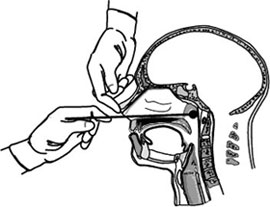| Nasopharyngeal swab | |
|---|---|
 Nasopharyngeal swab | |
| Purpose | Diagnosis of certain viral infections |
| MedlinePlus | 003747 |
A nasopharyngeal swab is a device used for collecting a sample of nasal secretions from the back of the nose and throat.[1][2] The sample is then analyzed for the presence of organisms or other clinical markers for disease. This diagnostic method is commonly used in suspected cases of whooping cough, diphtheria, influenza, and various types of diseases caused by the coronavirus family of viruses, including SARS, MERS, and COVID-19.[3][4][5][6][7][8]
- ^ "Nasopharyngeal culture". MedlinePlus. 23 March 2020. Retrieved 25 March 2020.
- ^ Pavord, T.; Pavord, M. (2004). The complete equine veterinary manual: A comprehensive and instant guide to equine health (2nd ed.). David & Charles. p. 206. ISBN 9780715318836.
- ^ Junkins, A. (2010). "20. Identification of Pathogenic Bacteria". In Mukherjee, K.I.; Ghosh, S. (eds.). Medical Laboratory Technology. Vol. 2 (2nd ed.). Tata McGraw-Hill. p. 515. ISBN 9781259000768.
- ^ "Specimen Collection". Pertussis (Whooping Cough). Centers for Disease Control and Prevention. 18 November 2019. Retrieved 25 March 2020.
- ^ Irving, S.A.; Vandermause, M.F.; Shay, D.K.; Belongia, E.A. (2012). "Comparison of nasal and nasopharyngeal swabs for influenza detection in adults". Clinical Medicine & Research. 10 (4): 215–8. doi:10.3121/cmr.2012.1084. PMC 3494547. PMID 22723469.
- ^ "Influenza Specimen Collection" (PDF). Centers for Disease Control and Prevention. n.d. Retrieved 25 March 2020.
A nasopharyngeal (NP) swab is the optimal upper respiratory tract specimen collection method for influenza testing.
- ^ McPherson, R.A.; Pincus, M.R. (2017). Henry's Clinical Diagnosis and Management by Laboratory Methods (First South Asia ed.). Elsevier. p. 1083. ISBN 9788131231272.
- ^ World Health Organization (19 March 2020). "Laboratory testing for coronavirus disease (COVID-19) in suspected human cases: Interim guidance, 19 March 2020". WHO/COVID-19/Laboratory/2020.5. World Health Organization. hdl:10665/331501. Retrieved 25 March 2020.